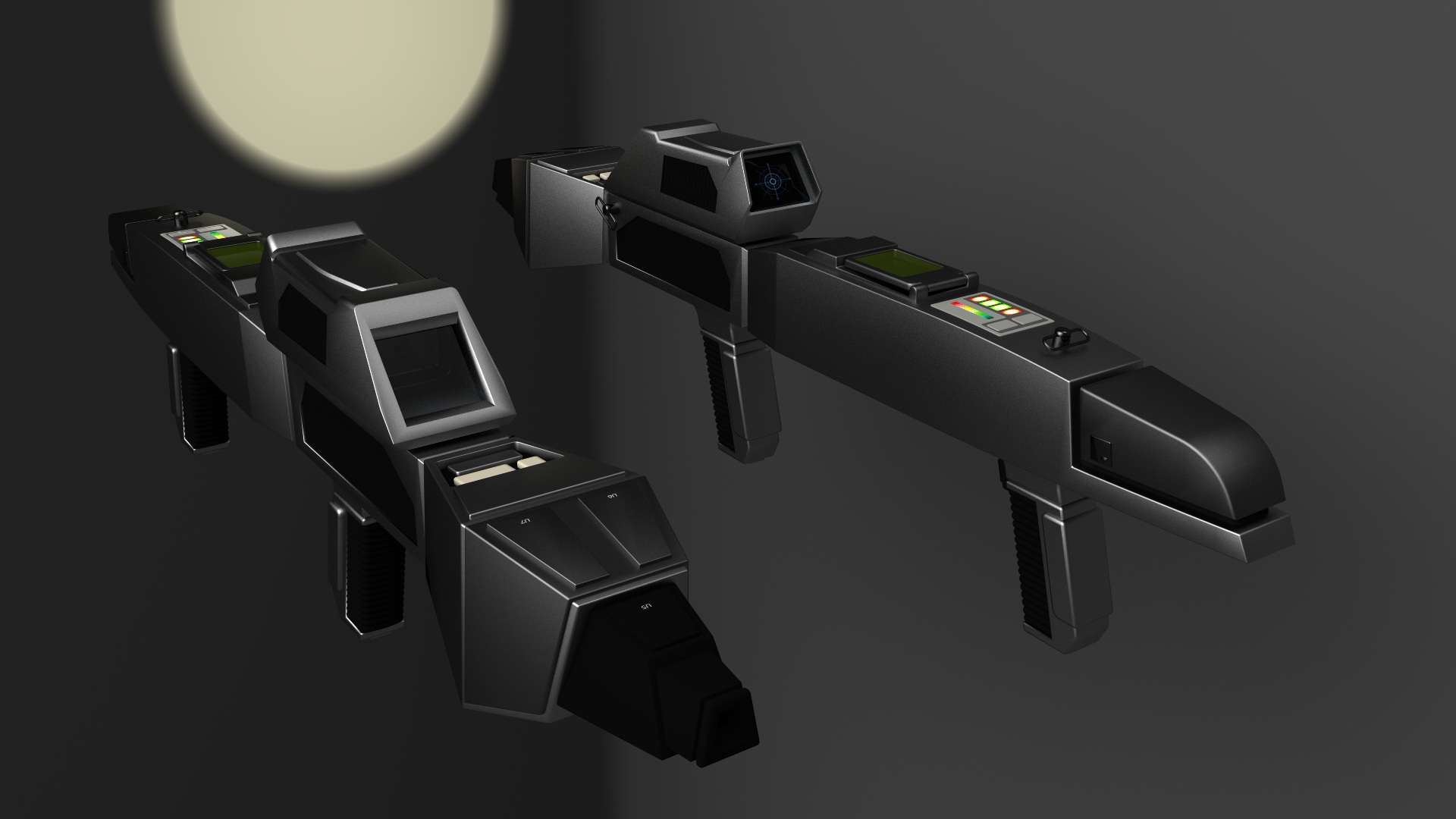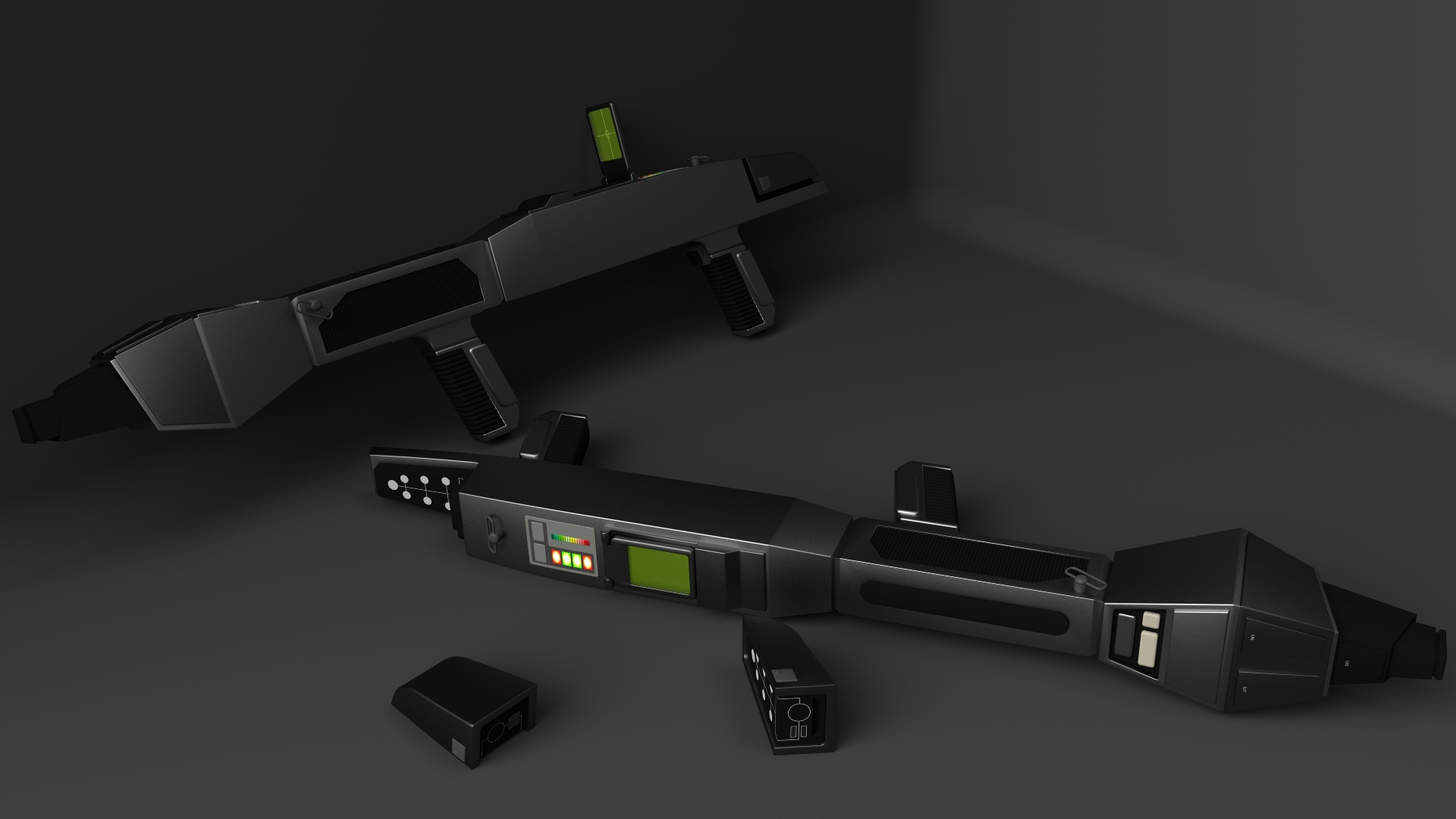huzzelwuzzel
About
- Username
- huzzelwuzzel
- Joined
- Visits
- 0
- Last Active
- Roles
- Member
- Points
- 2
- Posts
- 0
- Badges
- 0
-
TNG Phaser Rifle
Thanks.
Here's the flashlight attachment that can be seen in a few DS9 episodes:
Attachment not found.
A very important, though unfortunately rather rare and therefore more obscure attachment for the Type III Phaser Rifle was the Flashlight/Scope module. It was built to transfer at least some of the capabilities of the new Type IIIa to the existing Type III rifles.
Starfleet weapons, even the small Type I sidearms, are accurate up to several thousand meters. Their effective range is far shorter, for the simple reason that the human eye is unable to recognize targets at that range, much less track them properly. You could wave around the weapon and hope the beam hits something, but a more satisfactory solution for long-range engagements was needed.
The module is not a scope per se, instead it takes the image feed from the weapon's emitter boresight, normally invisible to the user and only used by the rifle's circuitry to triangulate the shooter's point of focus, and displays it on a small monitor at the back of the module. This view can then be zoomed and processed with IR and thermal imagery among others. Focussing on a target on the screen then aligns the gyro-stabilized emitter as usual, which then tries to negate hand shaking and hit the target at center of mass.
Another popular option is setting the screen to a "top down view" that shows targets identified by the rifle's motion tracker as blips.
Being placed on top of the upper interface rail, the module obscures the rifle's primary flipup-sight. An acceptable sacrifice considering the zooming options, and normal gyro-stabilized aiming "from the hip" was still possible as well.
The other, technically unimpressive part of the module is the flashlight pack. Though the Phaser beam could be set to such a low intensity and high width to emulate a flashlight, it takes precious moments to switch back to a lethal setting and so a simple, adjustable light projector was integrated to the front of the attachment. With its variable intensity and width, it not only helped orientation in low-light conditions, but was also used to blind enemies. It worked particularly well with Jem'Hadar soldiers, their genetically engineered eyes were designed to see better in darkness and were easily overstrained by sudden brightness.

-
TNG Phaser Rifle
This is the Type III Phaser Rifle i've been working on, in fact it's the late DS9 incarnation that was being used in the Dominion War.
I've also made up some fluff out of thin air. It's probably nonsensical and easily exposed as such, but here it is:
The Phased Energy Rectification Weapon Type III, or Phaser Rifle as it is most commonly referred to (although more colorful names are in use with Starfleet Ground Forces) is a directed energy weapon based on the rapid nadion principle. It was developed in the late 2350s, too late to see widespread use in the Federation-Cardassian War.
The years of relative peace afterwards didn't have much need for it either, and while a stash of rifles was placed on every major Starfleet facility, it was rarely given out to away teams and even Ground Forces on guard duty preferred their Type-Twos.
It was when the Cold Dominion War turned Hot that the Type III could show its true worth, but it was also when its weaknesses became obvious.
Combatting Jem'Hadar Soldiers required a high energy setting, and the rifle's power packs had only a slightly larger capacity than those of the Type II sidearm. A longer engagement often required two to three reloads.
Changing settings was also notoriously unergonomic, with the intensity and width controls placed in the "cobra head".
By the time Starfleet had already developed the Type IIIa Pulse Phaser Rifle, with a larger energy cell and a Flashlight/Scope pack.
The IIIa was acclaimed from all sides, but production was difficult and it was forseeable that it would come too late for the general war effort.
The short-term solution was to "overhaul" the existing Type IIIs in their depots. They were given sling attachments, an additional easier-to-reach control panel just behind the flip-up sight and the receivers were sanded to make them glare less. There was also a Flashlight/Scope pack similar to the one on the Type IIIa, but that was rather rare too and will be discussed in a seperate file.
Aiming:
Aiming with the Type III works just as with all Starfleet weapons years before and after. A sensor bar in the rifle actively scans the wielders eye and triangulates the focussed target with the boresight-picture.
The gyro-stabilized emitter chrystal is then aligned with the target, which often makes it seem as if the beam leaves the rifle at an awkward angle.
Slight shaking of hands is nullified by the gyro system too, so the weapon doesn't require a stock.
In effect all Starfleet weapons can be fired "from the hip", although this runs the risks of overstraining the gyro motor angles and of the sensor bar being unable to scan the Soldiers eye due to obstructions.
If the rifle is unable to determine the Soldier's point of focus (wearing sun glasses is an easy way to test that) or if his eyes don't stay focussed enough, the gyro motors are set to no angle and the weapon will shoot straight ahead. Beam degredation is negligible on a planetary engagement in any normal atmosphere, and all Starfleet weapons are point-accurate for several thousand meters.
Shooting a Phaser still requires regular training, but it is not aiming per se that's being trained, but rather the quick acquisition and identification of targets, and focussing enough while aiming so the gyro systems can do their work.
Here's where the rifle's flip-up sight comes into play. It highlights possible targets with brackets via an in-built motion tracker and superimposes a targetting reticule over the current point of focus. The sight also features infrared vision for bad light conditions.
Many seasoned officers and soldiers find the sight's systems distracting and leave it folded down, but it's always good to know it's there.
Reloading:
Reloading is simple, depress the release buttons on both sides of the used power pack, pull it off to the rear, place a new one on the reception and press it home. The contacts often carry a slight static charge and tend to attract dust particles, so it is always a good idea to blow off any grit residue during reload procedure.
It has also been observed that some users remove the head piece and blow on the prefire chamber contacts too, but this is more to bring luck since the system is normally closed.
The rifle has sixteen intensity settings, from weak stun to thermic vaporization. Cycling through the settings can take some time, so when Starfleet engineers added the new control panel they made sure to include four "speed dials" for preset settings.
Beam width can be changed too, but at such a loss in intensity that it is rarely used in combat. It can provide enough agony for a Changeling to lose his solid form though.
There's also the option to make the weapon fire short pulses instead of a steady beam, but the prefire chamber cannot store enough energy to make these pulses adequately powerful. The newer Type IIIa Pulse Phaser Rifle has an improved prefire chamber and is conceived from the beginning to fire pulses, which makes it harder for the enemy to determine the shooters position.
Additional credits
- Icons from Font-Awesome
- Additional icons by Mickael Bonfill
- Banner background from Toptal Subtle Patterns
© Scifi-Meshes.com 2001-2024
